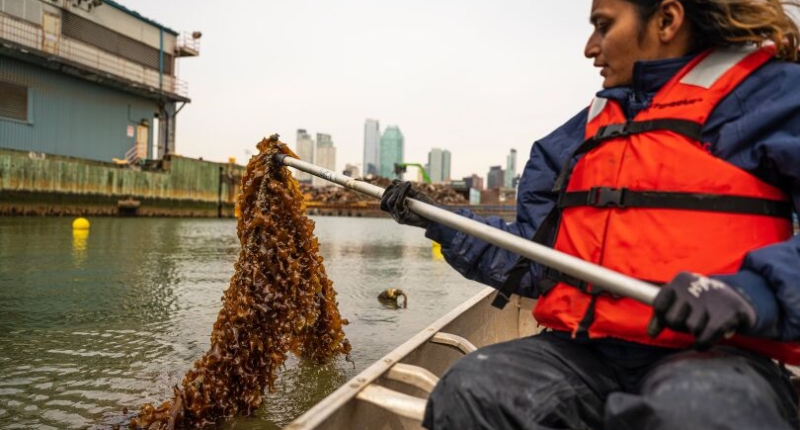Kelp farming is being studied and grown in polluted waterways around New York City as a means to improve water quality and restore marine ecosystems by sucking up carbon, nitrogen, and phosphorus from runoff and raw sewage. The kelp can also absorb heavy metals and toxins in the marine environment, and can lower ocean acidity, enhancing shellfish growth. Although commercial kelp farming is limited in New York, the state is issuing permits for kelp cultivation in public waters. Citizen science and community involvement is a driving force behind the kelp farming projects, with volunteers growing kelp in the Gowanus Bay and Newtown Creek in Brooklyn. The kelp is not suitable for consumption, but has potential to be used for biofuel, bioplastic, and even fertilizer. Additionally, kelp farming projects provide an opportunity to connect New Yorkers to the living environment and the neglected waterways surrounding them.
Kelp Farming to Combat Climate Change and Clean New York’s Polluted Waterways
The seaweed in Newtown Creek, Gowanus Bay, and the East River could be the solution to carbon and pollution issues in New York City. Kelp farming in these areas may help bolster marine ecosystems, reduce pollution levels, and combat climate change.
Volunteers with the Newtown Creek Alliance recently conducted an experiment to grow kelp in Newtown Creek. Despite its low salinity levels due to sewage overflows, the kelp grew successfully. Similarly, researchers at Stony Brook University’s School of Marine and Atmospheric Sciences are growing kelp in the East River, near the Throgs Neck Bridge.
Michael Doall, the associate director for shellfish restoration at Stony Brook University, is leading the project. He hopes to find answers to questions such as, “Can you actually do anything to improve water quality?” and “How much kelp do we need to grow to actually tip the balance in New York Harbor?”
Seaweed could potentially offer local environmental benefits and help fight climate change. Kelp can absorb carbon and pollutants, which could help reduce pollution levels in New York’s waterways. Kelp is also a natural habitat for marine organisms, which would strengthen marine ecosystems.
Although kelp farming is not new, the idea of using it to clean polluted waterways is a novel one. Seaweed is a small part of a solution to a very big problem, according to Doall. Nonetheless, kelp farming could be an effective way to improve water quality and fight climate change.
The kelp grown in Newtown Creek and other polluted areas is not suitable for consumption. Instead, kelp farming is an experiment to determine whether kelp can grow in these areas despite the low salinity levels. If successful, kelp farming could offer a new solution to the pollution problem in New York City.
Kelp Farming Could Combat Pollution in Newtown Creek
Newtown Creek, once used for commercial purposes since the 1800s, is now known for its toxic waters due to the waste and chemicals dumped in it over the years. The creek, which is a part of the Superfund National Priorities List, is expected to be cleaned up by 2032. However, kelp farming in the area could help to restore the marine ecosystem, as it can absorb carbon, nitrogen, and phosphorus from runoff and raw sewage. The nitrogen and phosphorus can cause harmful algal blooms and stifle marine life. Kelp farming could also absorb heavy metals and other toxins in the marine environment.
Kelp, which can grow up to 12 feet in five months and thrives in cold climates, could be especially effective in cleaning up Newtown Creek. Additionally, there is evidence that kelp can lower ocean acidity, enhancing shellfish growth. Though commercial kelp farming is limited in New York, the state Department of Environmental Conservation does issue permits to allow kelp cultivation in public waters. The Department of Agriculture and Markets regulates the distribution and use of the harvest, and entities that want to sell seaweed as a food must apply for a license.
In 2021, Gov. Kathy Hochul signed a bill for Suffolk County to lease underwater lands for commercial kelp farming, a move to boost the fishing economy and promote marine restoration. Nonetheless, the bill that would have expanded where kelp could be farmed was vetoed in 2022, citing the need for the Suffolk pilot program to be assessed.
Volunteers with the Newtown Creek Alliance have grown kelp in the creek to see whether it can thrive despite its low salinity levels. Stony Brook University researchers have also grown kelp in the East River near the Throgs Neck Bridge. Although kelp farming is not new, using it to clean polluted waterways is a novel concept. Seaweed is a small part of a solution to a big problem, according to Michael Doall, the associate director for shellfish restoration at Stony Brook University. Nonetheless, kelp farming could be an effective way to improve water quality and fight climate change.
Kelp farming in Newtown Creek may offer local environmental benefits and could help to combat climate change by reducing pollution levels in New York’s waterways. However, the kelp grown in the creek is not suitable for consumption. The experiment aims to determine whether kelp can grow in polluted areas like Newtown Creek and offer a new solution to the pollution problem in New York City.
Kelp Farming as a Solution to Environmental Pollution in New York City
Kelp farming in polluted waterways could offer a new solution to the environmental pollution problem in New York City. Newtown Creek, once used for commercial purposes since the 1800s, is now a toxic waterway due to the waste and chemicals dumped into it from heavy industrial uses. The creek is part of the Superfund National Priorities List and is expected to be cleaned up by 2032. Kelp farming in the area could help restore the marine ecosystem as kelp absorbs carbon, nitrogen, and phosphorus from runoff and raw sewage. Kelp farming could also absorb heavy metals and other toxins in the marine environment.
New York City’s Citizen Science
Newtown Creek Alliance, a group of volunteers, grew kelp in the creek to see whether it could thrive despite its low salinity levels. Meanwhile, researchers at Stony Brook University grew kelp in the East River near the Throgs Neck Bridge. Although kelp farming is not new, using it to clean polluted waterways is a novel concept.
Kelp grows quickly, up to 12 feet long in five months, and can thrive in cold climates like New York’s. There is also evidence that kelp can lower ocean acidity, thus enhancing shellfish growth. Although kelp farming is limited in New York, the state Department of Environmental Conservation issues permits to allow kelp cultivation in public waters. The Department of Agriculture and Markets regulates the distribution and use of the harvest, and entities that want to sell seaweed as food must apply for a license.
Elsewhere in Brooklyn, volunteers at the RETI Center are growing kelp in the Gowanus Bay, near the IKEA store in Red Hook. They’re testing how lines of kelp fare in varying depths of water and in an area where the tides often knock the lines out of place. The center will explore possibly using the harvested kelp for biofuel, as an additive to concrete, or to make bioplastic.
Connecting to Nature
In May, the volunteers at Newtown Creek plan to harvest only a portion of the kelp, leaving some in place on each line to see what happens to it as the water warms through the summer. New York City is about the southernmost limit of where sugar kelp can thrive. If the kelp withstands the climbing temperatures, it could act as a reef for other organisms to make a home on or near it.
Nick Russell, a researcher with the Newtown Creek Alliance and a student of environmental sciences at Queens College, sees kelp farming as a form of citizen science. “No one is growing a commercial species in a Superfund site—that’s nuts,” Russell said. “It’s really about using an organism that used to be native to this area in an impacted urban waterway for remediation. … The point is creating sort of a pilot for community involvement and citizen science.”
While the kelp grown in Newtown Creek is not suitable for consumption, kelp farming could be an effective way to improve water quality and fight climate change.
Kelp farming can create a sensory experience that connects New Yorkers to their environment, says Shanjana Mahmud, who is leading a kelp-growing project at Newtown Creek. When they harvested the kelp last spring and hung it to dry, Mahmud noticed speckles of barnacle larvae on the leaves and how the salty scent of the sea filled the air. “It was kind of this immediate reminder that this neglected waterway is still part of the earth,” she said.
Don’t miss interesting posts on Famousbio










